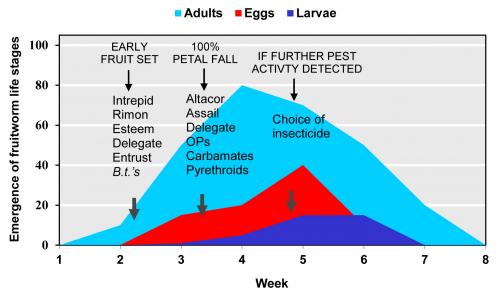Control options for fruitworms in blueberries for 2014
Performance characteristics of registered control materials for fruitworms can help guide management decisions in blueberry integrated pest management.
Cranberry fruitworm emergence is underway across Southwest Michigan and just starting to be caught this week at the Trevor Nichols Station in Fennville, Michigan. Cherry fruitworms have been flying for a while, and hotspots with petal fall should already be protected against this cherry fruitworm. This highlights that it’s time for protecting the new blueberry fruit from fruitworms. Some growers in advanced sites in Van Buren and Berrien counties have already done this starting late last week as petal fall progressed.
Natural enemies provide some suppression of fruitworm populations, and cultural controls such as clean cultivation or removing alternative hosts outside fields can help reduce the pressure from these pests. However, reaching the zero tolerance for infestation demanded by the large-scale food industry requires active management of these pests. If there is a consistent capture of fruitworm moths in your monitoring traps, application of insecticide starting approximately 100 growing degree days (GDD) after the first sustained catch is recommended by Michigan State University Extension. This is likely during bloom, and so it is very important to refrain from using compounds that are toxic to pollinators when these insects are in your fields. Applications early in the day or ideally late in the evening will help reduce the exposure to pollinators.
Products registered for use during bloom or in the presence of pollinators have provided consistent control of fruitworms in trials at the Trevor Nichols Research Center and at grower fields. These are the B.t. products such as Dipel or Javelin and the insect growth regulators Intrepid and Confirm. These products must be consumed by fruitworm larvae to be effective, so they are best applied over the top of fruitworm eggs so they are ingested as the larvae emerge. B.t. products have short residual activity, typically around five days, so they need regular reapplication. These are best applied when daily temperatures reach 70 degrees Fahrenheit so the larvae will actively feed and ingest the insecticide. Intrepid is more resistant to degradation by sunlight and it is much more waterproof once residues are dry, giving between seven and 14 days activity.
Other options for control of fruitworms during the egglaying period are the growth regulators Rimon and Esteem. These insecticides are highly active ovicides and they also disrupt the adult moth's ability to lay viable eggs, hindering the development of larvae. As with all insecticides, be sure to follow the label restrictions if making applications while bees are foraging in the fields. For all fruitworm control applications, excellent coverage of fruit clusters is required. This can be improved by the addition of a spreader-sticker to the spray water.
After 100 percent petal fall and removal of honey bees from the field, the range of options for fruitworm control increases, with Imidan, Asana, Danitol, Mustang Max, Lannate and Sevin being some of the available broad-spectrum insecticides. With all these products, maintaining good coverage is still important to get residue to the parts of the berry where fruitworms are found. Recent research trials in Michigan have demonstrated that EPA designated Reduced Risk insecticides Intrepid, Assail, Altacor, Entrust and Delegate applied after petal fall can also achieve excellent control of fruitworms, with minimal negative impact on natural enemies such as parasitic wasps, lady beetles and lacewings. Correct timing and coverage are critically important, so regular scouting of fields, use of sufficient spray volume to get good fruit coverage, and selecting appropriate spreader-stickers can increase activity of most insecticides applied for fruitworm control.
The table and figure below are designed to summarize several key factors that can help you select an insecticide for your integrated pest management program for fruitworm control in blueberries.
Details of insecticide options and timing for fruitworm control in blueberry
|
Compound trade name |
Chemical class |
Life-stage activity |
Optimal spray timing |
Pollinator/parasitoid toxicity rating * |
|
Imidan
|
Organophosphate |
Eggs, larvae, adults |
100% petal fall |
H |
|
Lannate/Sevin |
Carbamate |
Eggs, larvae, adults |
100% petal fall |
H |
|
Asana/Danitol/ Mustang Max/Hero/Bifenture
|
Pyrethroid |
Eggs, larvae, adults |
100% petal fall |
H |
|
Altacor |
Diamide |
Larvae |
100% petal fall |
S |
|
Assail |
Neonicotinoid |
Eggs, larvae |
100% petal fall |
M |
|
Entrust Delegate |
Spinosyn |
Eggs, larvae |
Early fruit set over eggs |
M |
|
Dipel |
B.t. |
Larvae |
Early fruit set over eggs |
S |
|
Intrepid |
Growth regulator |
Larvae |
Early fruit set over eggs |
S |
|
Rimon |
Growth regulator |
Eggs, larvae |
Early fruit set under eggs |
S |
|
Esteem |
Growth regulator |
Eggs, larvae |
Early fruit set under eggs |
S |
* Pollinator/Parasitoid Toxicity rating; S – relatively safe, M – moderate toxicity, H – Highly Toxic.
Population emergence of fruitworm adults, eggs and larvae and the optimal timing to begin sprays of different insecticide options. Follow the label caution for bees if making applications during bloom.

Drs. Wise and Isaacs’ work is funded in part by MSU‘s AgBioResearch.



 Print
Print Email
Email

